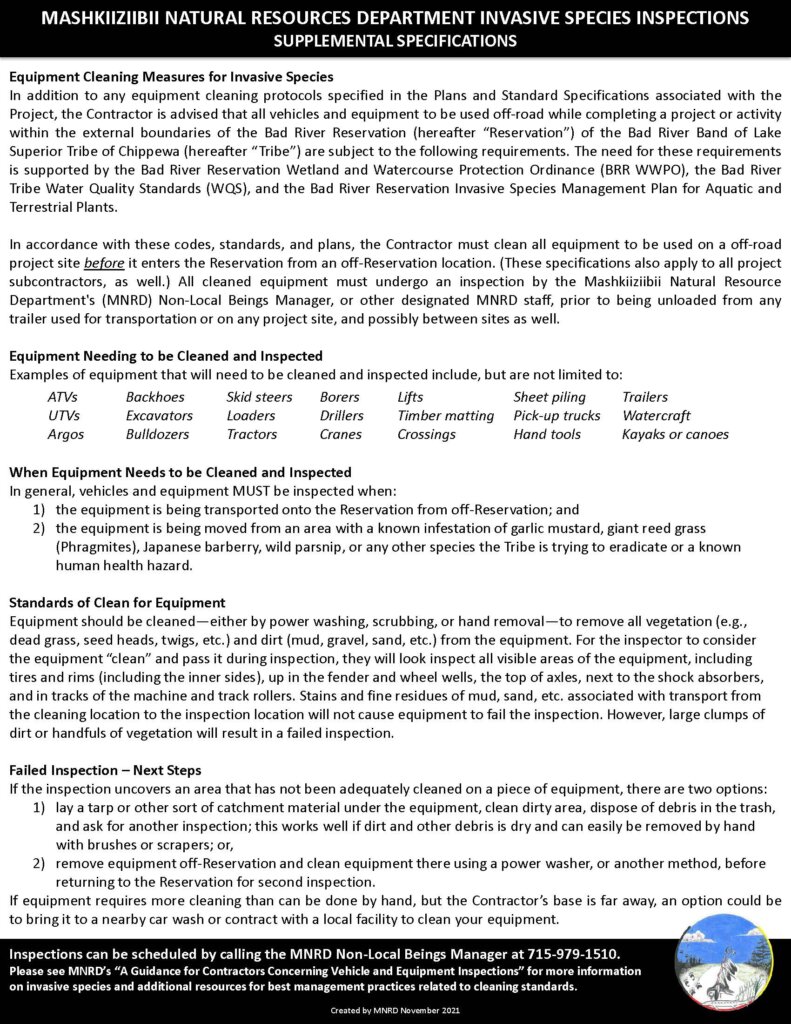Bakaan Ingoji Gaa-ondaadag
Non Local Beings
The Mashkiiziibii Natural Resources Department has adopted and enforces standards requiring all motorized and mechanical vehicles, pass-through equipment, watercraft and hand-tools to be cleaned and inspected before use within the Reservation. These inspections are performed by Bakaan Ingoji Gaa-Ondadaag program personnel in the interest of controlling and preventing the spread of aquatic and terrestrial invasive species populations known to threaten natural resources and ecosystem health, functionality, and fish and wildlife habitat. The documents below provide details about MNRD’s inspection procedures.
Any questions or concerns can be directed toward the Bakaan Ingoji Gaa-Ondadaag Program Manager.
Contact Information is at bottom of page or on Natural Resources Department page.


Non Local- Beings Projects
Planning for the use of Ishkode (fire) to control invasive species in the Kakagon Sloughs
Background
Exotic and hybrid apakweshkway (cattails; Typha angustifolia and Typha x glauca) and purple loosestrife (Lythrum salicaria) have established populations within the Reservation’s wetlands and wet substrate habitats, preferring wet meadows, marshes and swamps, bogs, fens, and can also be found on roadside ditches. Of particular concern are the excessive live and dead biomass prevalence of apakweshkway and purple loosestrife in the Bad River and Kakagon sloughs. These sloughs have critical ecological and cultural significance. This coastal freshwater estuary complex bordering Lake Superior provides ideal spawning and nursery habitat for several species migratory birds, fish – including Ogaa (walleye) and Name (lake sturgeon). Most importantly however, sheltered by a long coastal spit, the wetlands complex provides a pristine environment for the growth of Manoomin (wild rice). Long-term Manoomin population health, abundance, and site suitability are at risk of invasive apakweshkway and purple loosestrife competition in the Bad River and Kakagon sloughs. Furthermore, hand-pulling, biocontrol, and remediation efforts to reseed the sloughs have not fully balanced competing plant populations in the sloughs.
Objective
The Bakaan Ingoji Gaa-Ondadaag program is actively collaborating with the Manoomin program, the Bureau of Indian Affairs – Great Lakes Agency, the Northwoods Weed Cooperative, and the Great Lakes Indian Fish & Wildlife Commission to develop a management plan to use ishkode as an alternative treatment strategy to help strengthen the places for Manoomin to grow.
Methods
- Public involvement: MNRD staff are invested in hosting events and processes to solicit comments and public input to create an open and honest dialogue surrounding the possibility of reinstituting ishkode as a contributing conservation measure in the departments arsenal for managing nonlocal beings. Consistent with the Tribal Adaptation Menu and the 7th Generation Report, youth involvement is essential. The ishkode study provides a place for youth to be involved in Manoomin restoration, traditions and ceremony, and the importance of passing traditions on from generation to generation.
- Reach out to elders: Bad River’s elders are our most highly valued knowledge holders on the topic of ishkode. Their ideas and input will help ensure that our ongoing planning efforts incorporate and continue the traditions of our ancestors.
- Scoping work: scoping is the process of identifying and explaining the extent that a study or research area will pursue, and what parameters will be considered to evaluate its success. Once test plots are selected for ishkode, before and after pictures using MNRD’s geographic information system resources will help evaluate the eradication of live and dead apakweshkway and purple loosestrife biomass. Community involvement and notification of ceremony will take place prior to the use of ishkode.
Resources and Documents
Lake Superior Aquatic Invasive Species Complete Prevention Plan
Bad River Reservation Invasive Species Management Plan for Aquatic and Terrestrial Plants
Bakaan Ingoji Gaa-ondaadag Non Local Beings Contact Information: Program Manager Email nonlocalbeings@badriver-nsn.gov Office (715) 682-7123 ext: 1558 Direct (715) 979-1510 Technician Email nlbtech@badriver-nsn.gov Direct (715) 685-4443 |
